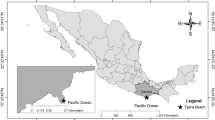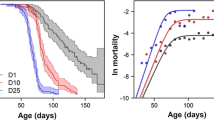Abstract
Populations of the freshwater copepod Mesocyclops edax inhabiting Michigan lakes are dormant during winter, whereas populations inhabiting Florida lakes develop and reproduce continuously throughout the year. A Michigan and a Florida population were exposed to dormancy inducing conditions (low temperature and short photoperiod) in the laboratory and observed for indications of dormancy. All Michigan individuals and a small percentage of the Florida individuals entered dormancy as indicated by prolonged duration of the fourth copepodid instar and cessation of feeding. I suggest that in these population these observations represent diapause, rather than quiescence. The two populations were crossbred to examine the nature of inheritance of dormancy. The F1 hybrids exhibited an incidence of diapause approximately intermediate between the Florida and Michigan parental stocks. The backcrosses of F1 individuals to the Michigan and Florida stocks, respectively, exhibited a high and an intermediate incidence of diapause. Survival of the F2 crosses was very low. The present study presents evidence of genetic differentiation between the Michigan and Florida populations of M. edax with respect to ability to diapause.
Similar content being viewed by others
References
Allan, J. D., 1984. Life history variation in a freshwater copepod: evidence from populations crosses. Evolution 38: 280–291.
Bishop-Rayle, J., 1988. Variation in dormancy of a Virginia population of the freshwater copepod Mesocyclops edax (Crustacea: Copepoda). M. S. Thesis, George Mason University, 104 pp.
Cole, G., 1953. Notes on copepod encystment. Ecology 34: 208–211.
Comita, G. W., 1972. The seasonal zooplankton cycles, production and transformation of energy in Severson Lake, Minnesota. Arch. Hydrobiol. 70: 14–66.
Danks, H. V., 1987. Insect Dormancy: An Ecological Perspective. Biol. Sur. Canada. 439 pp.
Dawes, C. J., B. C. Cowell, W. E. Gairdner, & S. M. Scheda, 1987. Limnological characteristics of two eutrophic and four mesotrophic lakes in west central Florida. Int. Revue ges. Hydrobiol. 72: 171–203.
Elgmork, K., 1962. A bottom resting stage in the planktonic freshwater copepod Cyclops scutifer Sars. Oikos 13; 306–330.
Elgmork, K., 1980. Evolutionary aspects of diapause in freshwater copepods. In W. C. Kerfoot (ed.), Evolution and Ecology of Zooplankton Communities. The University Press of New England, Hanover, (NH)); Lond.: 411–417.
Grice, G. D. & N. H. Marcus, 1981. Dormant eggs of marine copepods. Oceanogr. mar. Biol. annu. Rev. 19: 125–140.
Hairston, N. G., Jr. & E. J. Olds, 1986. Partial photoperiodic control of diapause in three populations of the freshwater copepod Diaptomus sanguineus. Biol. Bull. 171: 135–142.
Hairston, N. G., Jr. & W. R. Munns, Jr., 1984. The timing of copepod diapause as an evolutionary stable strategy. Am. Nat. 123: 733–751.
Hairston, N. G., Jr. & W. E. Walton, 1986. Rapid evolution of a life history trait. Proc. natn. Acad. Sci. USA 83: 4831–4833.
Marcus, N. H., 1987. Differences in the duration of egg diapause of Labidocera aestiva (Copepoda: Calanoida) form the Woods Hole, Massachusetts, Region. Biol. Bull. 173: 169–177.
Marcus, N. H., 1984. Variation in the diapause responses of Labidocera aestiva (Copepoda: Calanoida) from different latitudes and its importance in the evolutionary process. Biol. Bull. 166: 127–139.
Nilssen, J. P., 1977. Cryptic predation and the demographic strategies of two limnetic cyclopoid copepods. Mem. Ist. ital. Idrobiol 34: 187–196.
Papi\`nska, K., 1984. The life cycle and the zones of occurrence of Mesocyclops leuckarti Claus (Cyclopoida, Copepoda). Ekol. pol. 32(3): 493–531.
Papi\`nska, K., 1988. The effect of fish predation on Cyclops life cycle. Hydrobiologia 167/168: 449–453.
Smyly, W. J. P., 1961. The life-cycle of the freshwater copepod Cyclops leuckarti Claus in Esthwaite Water. J. anim. Ecol. 30: 153–169.
Smyly, W. J. P., 1962. Laboratory experiments with stage V copepodids of the freshwater copepod, Cyclops leuckarti Claus, from Windermere and Esthwaite Water. Crustaceana 4: 273–280.
Sokal, R. R. & F. J. Rohlf, 1969. Biometry. W. H. Freeman & Co., San Francisco, 776 pp
Strickler, J. R. & S. Twombly, 1975. Reynolds number, diapause, and predatory copepods. Verh. int. Ver. Limnol. 19: 2943–2950.
Stucke, D.,1981. Seasonality and distribution of two limnetic cyclopoid copepods, Diacyclops biscuspidatus thomasi S. A. Forbes 1882 and Mesocyclops edax (S. A. Forbes) 1881, in relation to lake thermal and oxygen structure. Case Western Reserve Univ. M. S. Thesis. 148 pp.
Tauber, M. J., C. A. Tauber, & S. Masaki, 1986. Seasonal Adaptations of Insects. Oxford Univ. Press. NY, 411 pp
Watson, N. H. F.,1986. Variability of diapause in copepods. In G. Schriever, H. K. Schminke, and C. -t. Shih (eds), Proc. of the Second Intl. Conf. of Copepoda, Ottawa, Canada 13–17 Aug 1984, Syllogeus 58: 509–513.
Watson, N. H. F. & B. N. Smallman, 1971a. The physiology of diapause in Diacyclops navus Herrick (Crustacea, Copepoda). Can. J. Zool. 14: 1449–1454.
Watson, N. H. F. & B. N. Smallman, 1971b. The role of photoperiod and temperature in the induction and termination of an arrested development in two species of freshwater cyclopid copepods. Can. J. Zool. 49: 855–862.
Wierzbicka, M., 1962. On the resting stage and mode of life of some species of Cyclopoida. Pol. Arch. Hydrobiol. 10: 215–229.
Williamson, C. E., 1984. Laboratory and field experiments on the feeding ecology of the cyclopoid copepod Mesocyclops edax. Freshwat. Biol. 14: 575–585.
Wyngaard, G. A., 1986. Genetic differentiation of life history traits in populations of Mesocyclops edax (Crustacea: Copepoda). Biol. Bull. 170: 279–295.
Wyngaard, G. A., Genetic relationships among life history traits in copepod populations: evidence of coadaptation. (in prep).
Wyngaard, G. A., J. L. Elmore & B. C. Cowell, 1982. Dynamics of a subtropical plankton community, with emphasis on the copepod Mesocyclops edax. Hydrobiologia 89: 39–48.
Author information
Authors and Affiliations
Rights and permissions
About this article
Cite this article
Wyngaard, G.A. Geographical variation in dormancy in a copepod: evidence from population crosses. Hydrobiologia 167, 367–374 (1988). https://doi.org/10.1007/BF00026327
Issue Date:
DOI: https://doi.org/10.1007/BF00026327




